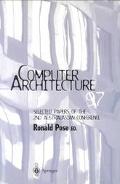

 |

|

The average rating for Computer Architecture `97 Selected Papers of the 2nd Australasian Conference based on 2 reviews is 3 stars.
Review # 1 was written on 2013-05-13 00:00:00 Leon DeCervantes Leon DeCervantes2008-12 - Everyday Architecture of the Mid-Atlantic: Looking at Buildings and Landscapes. Authors: Gabrielle M. Lanier, Bernard L. Herman. 424 pages. 1997 I picked up this book at the library as part of my self guided education for being a guide at Waynesborough. The book is hefty and has the look and feel of a textbook. While the text claims to focus on the Mid-Atlantic, most of the focus is in Delaware and Delmarva. The text reads easily for the first 65%. After this initial phase it starts to bog down in academic technical prose as it probes deeply into a few structures. It does this probe as a way to teach the reader how to apply archaeological techniques to building and site evaluation. The evaluation is a bit more rambling because it attempts to be as holistic as possible. This can cause the untrained to readily throw up their hands or to get bogged down in pet areas of interest. A more simplified checklist type of approach followed by a more in depth methodology for those points on the checklist would be helpful. The initial section is interesting and does provide quite a bit of information due to its approach. This book does more than try to identify a house and its era and show how this was done. The approach starts with function and location. It tries to show how the landscape or lot influences the function and design as well. To this end it does an adequate job of providing the reader with context for a building rather than looking at a structure in isolation. Once the readers has gotten a grasp of the context of the building the text move son to various varieties and evolutions of construction material and technique and how they influenced the structure it self. The book does not limit itself to houses. In the process of providing context through lot surveys the book deals with the various varieties of both urban and rural outbuilding. The study of outbuildings covers the evolution and typical location of the buildings. This aspect of the text proved most interesting because so much f the e history of these common outbuildings has been lost due to technological innovations such as indoor plumbing, electric refrigeration and other advances. Besides houses and their attendant outbuildings the text address barns, sheds, factories, and commercial buildings as well. This type of architecture is often reserved to serious students as most casual readers are enamored of houses. The eras portrayed begin in the earliest days of settlement and proceed forward to near the mid-20th Century. The book is well provided with photographs to illustrate ideas and structures as well as line drawings. The later proved especially useful in describing and providing understanding to how structures are built and where they are located. |
Review # 2 was written on 2018-02-21 00:00:00 Louisa-magdalene Papadopoulou Louisa-magdalene PapadopoulouThis is a book for the general public—lots of illustrations and easy read for those unfamiliar with building preservation. 350 pages on colonial mansions, barns, muskrat-skinning sheds, etc. in this book about a “region of regions”—the Delaware Valley. Delaware-centric, as the two contributors worked their at the Center for Historic Architecture and Design (in collaboration with HABS), but it does include regional examples from NJ, PA, MD, and VA as well. This is not style-obsessed but instead focuses on change over time in looks and use (an archaeological approach): not looking for purity but dissecting alterations. It argues for the study of buildings to better understand people: “how they saw themselves, their neighbors, and their workday world in all its complexity—and how they projected that sense of self and society into the substance of their environment" (350). |
CAN'T FIND WHAT YOU'RE LOOKING FOR? CLICK HERE!!!